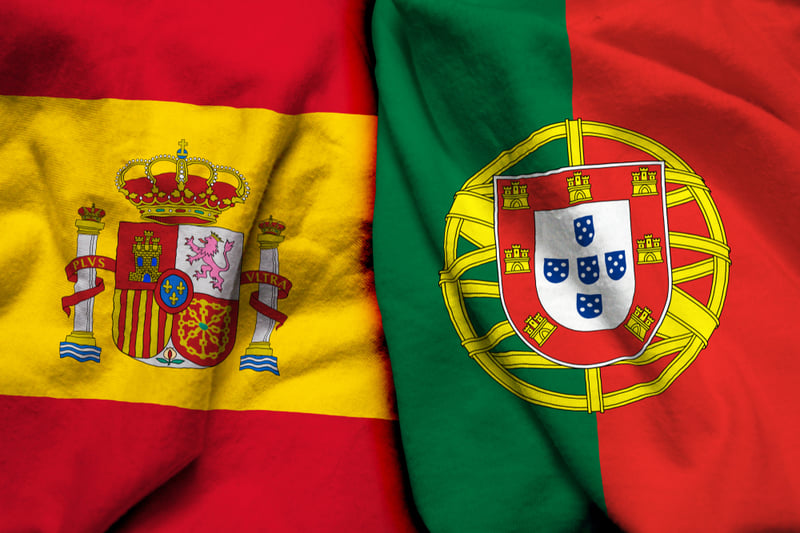Whether you’re a native Spanish speaker, or you just took a few years of Spanish in school, you may be curious about the similarities and differences between Spanish and Portuguese.
Are 🇵🇹Portuguese and 🇪🇸Spanish Basically the Same?
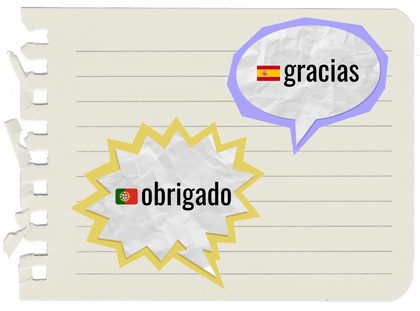 No. First, let’s clear one thing up: Portuguese and Spanish are not just dialects of the same language. They are both distinct languages. However, they do share a lot of similarities because of their common roots.
No. First, let’s clear one thing up: Portuguese and Spanish are not just dialects of the same language. They are both distinct languages. However, they do share a lot of similarities because of their common roots.
When you read phrases like this, it’s easy to assume that Spanish and Portuguese are basically the same:
🇪🇸 Estoy triste | 🇵🇹 Estou tristeI'm sad
🇪🇸 Su camisa es azul | 🇵🇹 A sua camisa é azulYour shirt is blue
🇪🇸 ¿No hay papel para la impresora? | 🇵🇹 Não há papel para a impressora?Is there no paper for the printer?
🇪🇸 ¿A qué hora viene? | 🇵🇹 A que horas vem?What time are you coming?
However, when you dig a little deeper, it’s not so simple:
🇪🇸 Gracias | 🇵🇹 ObrigadoThank you (male speaker)
🇪🇸 Vale | 🇵🇹 PoisYeah, okay, well
🇪🇸 Es el cubo de la basura | 🇵🇹 É o caixote do lixoIt's a trash can
🇪🇸 Los perros desayunaron | 🇵🇹 Os cães tomaram o pequeno-almoçoThe dogs eat breakfast
🇪🇸 La carnicería está en esa calle | 🇵🇹 O talho está naquela ruaThe butcher shop is on that street
🇪🇸 Hice la cena ayer, pero el pollo me sentó mal | 🇵🇹 Ontem fiz o jantar, mas o frango pôs-me doenteYesterday I made dinner, but the chicken made me sick
🇪🇸 Se quedó en la tienda | 🇵🇹 Ficou na lojaYou stayed at the store
🇪🇸 He olvidado cómo bailar | 🇵🇹 Esqueci-me como se dançaI forgot how to dance
In practice, some Spanish and Portuguese speakers say they can understand each other (at least on a very basic level), but they have a much easier time with the written language compared to the spoken language. There is also more mutual intelligibility between certain dialects, and it helps if the speakers have had some exposure to the other language.
Ultimately, it’s not a 2-for-1 deal when learning Spanish or Portuguese, but there is certainly a lot you can build from. We’ll cover some of the similarities and differences below, including common mistakes to avoid!
Please note that we’re focusing on Castilian Spanish (Spanish spoken in Spain) and European Portuguese (Portuguese spoken in Portugal).
Why Are Portuguese and Spanish Similar?
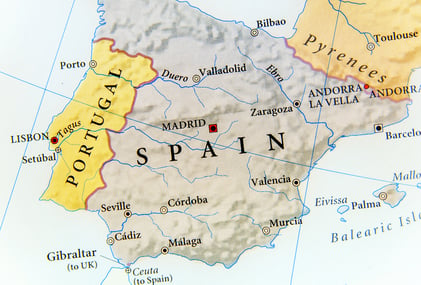 If you’re familiar with the geography of the area, it’s no surprise that Portuguese and Spanish have so many similarities. Portugal and Spain make up most of the Iberian peninsula, which is separated from the rest of Europe by the Pyrenees Mountains. This means that the languages developed in a way that was more isolated from other European languages.
If you’re familiar with the geography of the area, it’s no surprise that Portuguese and Spanish have so many similarities. Portugal and Spain make up most of the Iberian peninsula, which is separated from the rest of Europe by the Pyrenees Mountains. This means that the languages developed in a way that was more isolated from other European languages.
Now for a super-condensed version of what is a long and complicated history…
Latin was spoken in the Roman Empire, and over time different variations of Latin emerged throughout Europe as it came into contact with the many other regional languages.
As the Roman Empire began to fall, there were many other groups that invaded, including Germanic Gothic-speaking tribes. However, Gothic remained mostly an upper class language and didn’t catch on with most of the general population. Later when the Moors took control of the region, Arabic was the primary upper class language. But again, it didn’t catch on with the rest of the mostly-Christian population. This is why there are many Gothic and Arabic loanwords, but the influence of Vulgar Latin (i.e. the way Latin was spoken colloquially) persisted.
During the Reconquista (the Christian reconquering of Spain), Vulgar Latin spread due to the kingdom of Asturias, which was not conquered by the Moors. Asturias eventually broke into different kingdoms, including León, Galicia, and Castile, giving rise to more variations. One of the variants of Galicia gave rise to what is now Portuguese and Castilian gave rise to what is now Spanish.
Portugal was conquered and reached stability earlier, while Spanish continued to evolve over time with other influences. This explains why the Latin features are more prevalent in Portuguese compared to Spanish.
Now let’s dive into the details of how Spanish and Portuguese compare in their vocabulary, grammar, and pronunciation.
Vocabulary
There are a number of spelling patterns you may notice when comparing Portuguese and Spanish words. If you’re familiar with Spanish, these can be a good shortcut for picking up lots of Portuguese vocabulary quickly. In the examples below, we’ll show you the Spanish spelling first and then the Portuguese:
- -dad → -dade
- 🇪🇸 la ciudad | 🇵🇹 a cidadecity
- -ción → -ção
- -zon → -ção
- 🇪🇸 el corazon | 🇵🇹 o coraçãoheart
- -ble → -vel
- -an → -am
- -b between vowels → -v
- 🇪🇸 haber | 🇵🇹 haver
- j → lh or x
- h at beginning → f
- ñ → nh
Cognates / Similar Words
Spanish and Portuguese have many cognates, which is the term for similar-sounding words that have the same meaning in both languages. In some cases, the spelling is even the same, but the pronunciation differs, or vice versa.
- 🇪🇸 cuenta | 🇵🇹 a contabill, check, account
- 🇪🇸 fuego | 🇵🇹 o fogofire
- 🇪🇸 policía | 🇵🇹a políciathe police
- 🇪🇸 Señora | 🇵🇹 Senhoralady, Madam, Mrs.
- 🇪🇸 año | 🇵🇹 o anoyear
- 🇪🇸 país | 🇵🇹 o paíscountry
- 🇪🇸 pequeño | 🇵🇹 pequenosmall
- 🇪🇸 comer | 🇵🇹 comerto eat
- 🇪🇸 sol | 🇵🇹 o solsun
- 🇪🇸 agua | 🇵🇹 a águawater
- 🇪🇸 Disculpe | 🇵🇹 DesculpeSorry, Excuse me
- 🇪🇸 y | 🇵🇹 eand
False Friends / False Cognates
Be careful, though, because there are also a number of false cognates! These are words that look/sound similar, but actually have very different meanings. Here are some words you don’t want to mix up in Spanish and Portuguese:
- 🇪🇸 polvo – dust | 🇵🇹 o polvooctopus
- 🇪🇸 embarazada – pregnant | 🇵🇹 embaraçadaembarrassed, entangled
- 🇪🇸 exquisita – delicious, exquisite | 🇵🇹 esquisitaweird
- 🇪🇸 rojo – red | 🇵🇹 roxopurple
- 🇪🇸 borracha – drunk | 🇵🇹 a borracharubber, eraser
- 🇪🇸 engrasado – greasy | 🇵🇹 engraçadofunny
- 🇪🇸 niño – boy | 🇵🇹 o ninhonest
- 🇪🇸 salsa – sauce | 🇵🇹 a salsaparsley
- 🇪🇸 salada – salty | 🇵🇹 a saladasalad
- 🇪🇸 ano – anus | 🇵🇹 o anoyear
Grammar
Now let’s talk about what’s similar in Spanish vs Portuguese grammar:
- Both use the verbs ser and estar
- Both generally use the same word order (SVO)
- Both employ grammatical gender
- Many adverbs are formed by adding -mente
- Similar verb conjugations
- Similar use of auxiliary verbs
What about the differences in grammar?
- Usage
- Even though there is shared vocabulary, there are many differences in the usage of those shared words. For example, even though the verb necesitar exists in both languages with the same meaning, precisarto need is much more commonly used in Portuguese.
- Informal Future Tense
- Spanish uses the ir + a + infinitive construction, while Portuguese uses just ir + infinitive
- 🇪🇸 Voy a bailar → 🇵🇹 Vou dançarI'm going to dance
- Spanish uses the ir + a + infinitive construction, while Portuguese uses just ir + infinitive
- Present Continuous
- Spanish uses the estar + gerund construction, while European Portuguese uses estar + a + infinitive
- 🇪🇸 Estoy leyendo el periódico → 🇵🇹 Estou a ler o jornalI'm reading the newspaper
- Spanish uses the estar + gerund construction, while European Portuguese uses estar + a + infinitive
- Clitic Pronoun Placement
- The rules are different for when to place reflexive pronouns and other clitic pronouns before or after the verb. For example:
- Possessives
- With Portuguese possessive pronouns/determiners, you have to take the gender of the item being possessed into account. In Spanish you only need to think about the gender of the person. For example:
- 🇪🇸 su → 🇵🇹 seu / sua
- 🇪🇸 tu → 🇵🇹 teu / tua
- 🇪🇸 mi → 🇵🇹 meu / minha
- With Portuguese possessive pronouns/determiners, you have to take the gender of the item being possessed into account. In Spanish you only need to think about the gender of the person. For example:
- Contractions
- Portuguese has a long list of contractions, whereas in Spanish there is just de + el = del and a + el = al.
- Personal infinitive
- Portuguese has the personal infinitive, which can be conjugated. Spanish has only the impersonal infinitive form.
- 🇪🇸 Nos vamos temprano para ver todo | 🇵🇹 Nós vamos cedo para vermos tudoWe're going to go early to see everything
- Portuguese has the personal infinitive, which can be conjugated. Spanish has only the impersonal infinitive form.
- Subject Pronouns
- 🇪🇸 yo → 🇵🇹 euI, me
- 🇪🇸 tu → 🇵🇹 tuYou (sing.,inf.)
- 🇪🇸 él → 🇵🇹 elehe
- 🇪🇸 ella → 🇵🇹 elashe
- 🇪🇸 usted → 🇵🇹 vocêyou (formal)
- 🇪🇸 nosotros → 🇵🇹 nósus, we
- 🇪🇸 vosotros → 🇵🇹 vósyou (informal plural, archaic) (Another form of you(pl.). Nowadays it’s less common, except in certain areas of Portugal or very formal contexts.)
- 🇪🇸 ellos → 🇵🇹 elesthey
- 🇪🇸 ellas → 🇵🇹 elasthey
- 🇪🇸 ustedes → 🇵🇹 vocêsyou (pl.)
Pronunciation
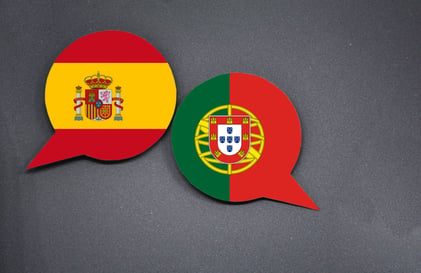 Pronunciation tends to be the most obvious differentiator when comparing Portuguese and Spanish. Portuguese contains more speech sounds than Spanish, and Portuguese pronunciation is more variable (i.e. there are more ways to pronounce the same letter). This is why listening practice is so essential for Portuguese learners with a background in Spanish.
Pronunciation tends to be the most obvious differentiator when comparing Portuguese and Spanish. Portuguese contains more speech sounds than Spanish, and Portuguese pronunciation is more variable (i.e. there are more ways to pronounce the same letter). This is why listening practice is so essential for Portuguese learners with a background in Spanish.
Vowels
- 🇵🇹 Portuguese vowels are quite complicated: There are open and closed versions, plus many reduced vowels, diphthongs, and nasalized vowels.
- 🇪🇸 Spanish vowels are more straightforward: There are only 5 (a, e, i, o, u), compared to Portuguese’s 14, plus a few diphthongs.
Consonants
There are a few Portuguese consonants you should be especially aware of when comparing to Spanish:
- j and g
- 🇪🇸 el jugo – juice | 🇵🇹 o jogogame
- ch: Sounds like “ch” (/ʧ/) in Spanish and “sh” (/ʃ/) in Portuguese
- 🇪🇸 los cheques – checks | 🇵🇹 os chequeschecks
- s: Always the same in Spanish, but in Portuguese it can be pronounced like “s”, “z”, or “sh”, depending on the context
- 🇪🇸 las rosas – roses | 🇵🇹 a mesatable o passaportepassport o mêsmonth
- d: Both Spanish and Portuguese sometimes use a more dental “th” sound for “d”, when compared to a hard English “d”, but both also have the harder d. It depends on the context.
- b and v: This sound is softer in Spanish, and sounds the same as the “b”. In Portuguese, “b” and “v” are pronounced differently and they sound closer to the English versions.
- 🇪🇸 la vaca – cow | 🇵🇹 a vacacow
- 🇪🇸 bajo – short, low |🇵🇹 baixoshort, low
- r: Both languages have the alveolar tap/flap and generally it appears in the same contexts. When there’s a double rr, it is rolled near the front of the mouth in Spanish, whereas it’s more glottal / in the back of the mouth in Portuguese. (Some Portuguese dialects pronounce rr more like the Spanish rr, though.) The R at the beginning of Portuguese words is also more glottal. More info on the Portuguese R.
- 🇵🇹 nh: Similar to 🇪🇸 ñ
- 🇪🇸 España – Spain | 🇵🇹 a EspanhaSpain
- 🇵🇹 lh: Somewhat similar to 🇪🇸 ll
- 🇪🇸 la toalla – towel | 🇵🇹 a toalhatowel
- 🇪🇸 la paella – a popular Spanish dish | 🇵🇹 a palhastraw
What is “Portunhol” / “Portuñol” ?
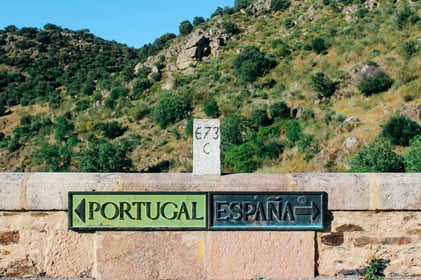 You may have heard the term Portunhol or Portuñol, which is simply a portmanteau of the words:
You may have heard the term Portunhol or Portuñol, which is simply a portmanteau of the words:
🇪🇸 portugués | 🇵🇹 portuguêsPortuguese
and
🇪🇸 español | 🇵🇹 espanholSpanish
It’s not a true language, but rather an unstandardized result of “code-switching”. Basically, when a native speaker of one language speaks the other language, they will spontaneously end up mixing the two languages together due to the influence from their native language. It’s especially common to hear Portunhol in areas near the border of Spain and Portugal.


